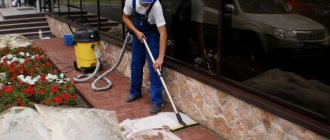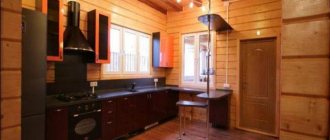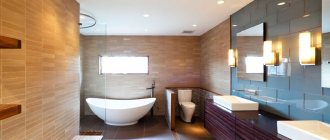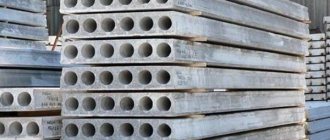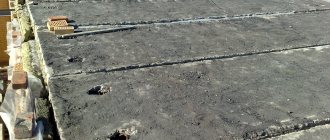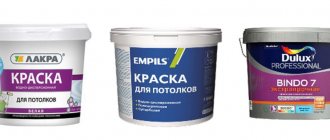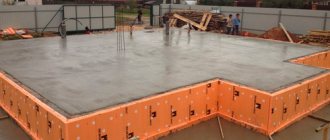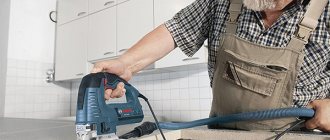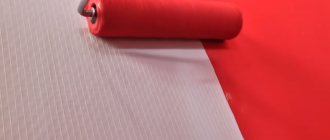Applications and properties of OSB boards
Oriented strand boards, or OSV, are a relatively new material used for finishing walls inside a house, as well as for installation on its external surfaces. Often, slabs are used to install floors. Among the main advantages of the material are the ability to quickly cover surfaces, durability, strength and ease of installation. At the manufacturing plant, the boards are impregnated with special protective compounds that prevent the material from rotting under the influence of moisture, UV rays, pests and chemicals.
In most cases, factory impregnation is enough to transport and store the slabs, but after installation the material requires finishing. The most affordable method is painting OSB. It provides benefits such as:
- reliable protection from precipitation and moisture;
- preventing cracking and deformation;
- protection against delamination under the influence of UV rays and high temperatures;
- relatively low price.
All these advantages of painting make it one of the most popular methods of finishing OSB boards. Let's look at what compositions are suitable for applying to the slab outside the building, as well as for treating surfaces inside it.
How to choose a material - pros and cons of different types of paint
The most versatile option for painting surfaces is finishing with oil paints. Syntilor formulations are very popular among specialists.
and
Coloray
. These paints have excellent adhesion and high viscosity. Thanks to this, the slabs do not absorb them. Thus, a reliable protective layer is formed on the surfaces, which can last at least 2 years on the facade and more than 3 years in the room itself.
Alkyd enamel differs from oil enamel in its ability to absorb quickly. This affects the consumption of the composition, but such paint is able to form a stronger and more durable protective layer.
Alkyd paints are also suitable for working on surfaces inside and on the facade of a building.
These compositions do not require the application of a varnish layer, which makes it possible to save a little. Among the most popular brands is Enamel
.
Tikkurila
and
Farbex
.
A little less often, water-based paints are used to work with OSB boards. This is due to the fact that the slabs can swell under the influence of the coloring composition. However, this does not prevent the use of Aqualak for working with floors, partitions and internal walls due to the environmental friendliness of the composition and the absence of harmful impurities and odor in it. Among the entire range, experts highlight compositions from Dulux
,
Teknos
and
Sadolin
.
The most optimal method for OSB is painting with solvent-soluble compounds. These paints penetrate deep into the slabs, where they react with synthetic resins. As a result, they form a tight, reliable connection, the service life of which is measured in tens of years. This method is excellent for finishing facades, OSB fences and fences. The highest quality compounds are considered to be products from International Paint.
and
Sigma Coatings
.
Wood boards are a fairly high-quality and inexpensive material for finishing work. Their original texture is made up of wood chips. The sheet is formed using certain types of polymer resins and glue. For better preservation and protection from moisture, OSB panels are treated with special paints - only in this way will the finishing material be preserved for many years.
Before painting the OSB board inside the house, you need to take into account that this material is available in four types. Each of them has its own properties that determine its scope:
- OSB1 - low-density panels without water-repellent treatment, mainly suitable for interior wall decoration, except in rooms with high humidity.
- OSB2 - have a little more strength than the first type, but this board also needs to be protected from moisture by painting.
- OSB3 is the most common panel with high strength and moisture resistance. However, with prolonged contact with moisture, the sheet begins to deform, so the panel outside the building will have to be treated with at least a special impregnation.
- OSB4 is a heavy-duty material that can withstand high humidity environments. But there is also a minus - the high price.
How to paint OSB board
The abbreviation OSB in translation means oriented strand board and can be called OSB (in transcription from English) or OSB - in Russian abbreviation. This is a relatively new type of improved wood, which has become widely used in construction as a finishing material.
OSB board
In terms of technical characteristics such as strength, service life, weight, fire safety, OSB boards have advantages over MDF, chipboard, fiberboard and even plywood.
But, like any tree, this material requires additional protection - necessarily, or decoration - if desired. The most affordable way to achieve this is coloring.
And here it is important to know how to paint an OSB board under various conditions of its use.
Features of OSB painting compositions
The specificity of the multilayer structure of the OSB board material, the basis of which is small chips in an adhesive connection with various resins, imposes special features on the choice of composition for painting them.
In order to accurately determine the paint needed in specific conditions, it is important to know the main characteristics, pros and cons of paint and varnish compositions used for OSB
Organosoluble paints
A good option for processing OSB are paints and varnishes based on organic solvents. There are two groups of such paints:
- Oily.
- Alkyd.
The drying process of both occurs as a result of oxidation when interacting with air and takes a relatively long time - up to several days. But alkyd resins contain special additives that accelerate the drying rate of the dye.
Positive qualities of solvent-soluble paints:
- resistance to environmental influences;
- anti-corrosion effect;
- good adhesion;
- low price.
An additional advantage is some savings due to efficient consumption.
- toxicity;
- low light fastness.
Alkyd compositions are the most popular among solvent-soluble paints, due to their ease of application to the surface, greater weather resistance and shorter drying time.
It is important to consider that in order to avoid swelling of alkyd paint, the surface of the wood must be completely dry
Water-dispersed compositions
Due to the binding resins and polymers, the OSB surface is sufficiently moisture resistant for painting with acrylic water emulsions. The exception is boards with a high level of hygroscopicity (OSB-1, OSB-2).
The main advantage of acrylic and latex water-emulsion solutions is their environmental friendliness. Other useful features include:
- ease of use;
- large selection of colors;
- resistance to temperature changes and direct sunlight;
- non-flammability;
- no unpleasant odor.
The peculiarity of water-dispersed dye is low adhesion to smooth substrates, so preparation of the material is necessary - a primer. Water-based rubber paints and special facade paints containing latex work well on complex and unprepared surfaces.
Impregnations and varnishes
For hydrophobic and decorative treatment of OSB boards, impregnations, varnishes, and azures can be used.
The recommended varnish for OSB is urethane-alkyd yacht varnish, which has good wear resistance and weather resistance.
We do it ourselves: how to prepare and paint OSB indoors and outdoors?
The main difficulty with painting Oriented Strand Board sheets, especially grades 3 and 4, is their high moisture resistance. It is difficult to find a suitable composition that would demonstrate decent adhesion, so the slab should first be sanded with sandpaper to roughen the surface. Don't forget to putty the joints of the sheets using wood putties. Some people prefer to make homemade mixtures using gelatin and casein.
Step No. 1: preparatory work technology
In order to increase adhesion, moisture-resistant sheets on the floor or walls should be treated with acrylic primer. Before painting OSB indoors with non-water-based paints, the boards are primed with drying oil or polyurethane varnish. Primers based on synthetic resins have proven themselves to be excellent.
To obtain a perfectly flat surface, craftsmen often putty the entire surface to be treated. To prepare a moisture-resistant slab from the outside, you need compounds that are used to prime the surface before applying textured and mosaic plasters.
The technique for preparing panels on the outside of a building is practically no different from interior work. Additionally, it is recommended to treat them with antiseptic compounds and fire retardants. It doesn’t hurt to take into account the fact that the surface quality of each manufacturer differs significantly.
Step No. 2: how to paint OSB wood board inside and outside the house
In practice, the choice of paint depends on the type of particle board. In this regard, OSB1 and OSB2 are universal - they can be treated with both water-dispersion compositions and PVA- or acrylic-based paints. It is important to consider that although these sheets have good hiding power, due to their large porosity, the cost overrun can reach up to 50% compared to plywood or wood.
Among professional builders, there are certain rules when processing particle boards with paints and varnishes:
- The paint must be made on a polymer base; an emulsion based on an aqueous solution is not suitable for finishing work.
- Compositions based on acrylates will help make the surface convenient for subsequent cleaning and washing.
- To provide additional protection from moisture, you need to use materials containing alkyd, latex and polyurethane components.
Homeowners who decide to learn how to properly paint OSB indoors should take into account the specifics of the work. First of all, it lies in the particularly pronounced texture of the material. The paint will spread over the body of the wood chips, so 2-3 layers of paint will be required for a good coating. For those interested in decorating slabs, this fact will be to their advantage - several layers of color will contribute to the implementation of original visual effects.
Tinting and multi-color painting are generally acceptable only for sheets with pronounced moisture absorption. As for moisture-resistant specimens, in cases where installation on a floor with insulation is not provided, enamels based on chemical solvents should be used:
- Alkyd.
- Oily.
- Polyurethane.
Preparing the surface for painting
The paint consumption and the final appearance of the finish depend on how well the OSB surface is prepared before painting. The purpose of the preparatory measures is to increase the adhesive properties of the panels and eliminate unevenness in the material and junction areas. The work is performed according to the following algorithm.
- Sand the entire surface of the OSB with sandpaper. This will remove the factory protective coating and increase the adhesive properties of the surface.
It is most convenient to pre-sand the sheets before installation begins.
The most commonly used putty is acrylic based. - Check the surface of the slabs for chips, cracks and other irregularities. After this, the joints are filled with special sealing compounds or covered with mounting strips, and defective areas and joints are leveled with putty for wooden surfaces.
- After the putty has dried, the slab is sanded again using fine-grain sandpaper.
In order to achieve a perfectly flat surface, they often resort to continuous puttying of the entire mounted surface.
- The last preparatory stage is the primer. The use of 1-2 layers of special polyurethane and acrylic compounds increases adhesion and reduces the absorption of the base paint coating.
Painting composition or how to paint OSB wood board on the facade of a building?
To cover OSB panels outdoors, you need special paints. The composition intended for interior work is not used here. The level of its environmental friendliness is much higher, and therefore the price is corresponding, so it is not economically profitable to use such material for exterior finishing. The technical side of the issue also plays a role:
- Facade paint must have a high level of vapor permeability.
- The coating must prevent moisture from entering the surface of the panels.
- The best choice for panels with low moisture resistance would be latex and silicone based paints.
In reality, painting the slab and photos of the preparatory processes demonstrate that the outer OSB3 cladding is first coated with a primer. For these purposes, GF-020 and GF-021 soils have proven themselves to be excellent. Before painting the OSB board on the facade with a primer, it is first sanded and cleaned of dust.
For moisture-resistant sheets, alkyd enamels are suitable, which have repeatedly demonstrated examples of durable coatings. When implementing design projects, the surface is covered with stain, but the question may arise as to what varnish to cover the texture with. The answer is simple - vinyl or polyurethane; the decorative benefits of such treatment are very noticeable.
Preparing paint and applying it
Paints and varnishes are usually applied to OSB panels in at least two layers. The first is diluted with 10-15% solvent of the appropriate type. Depending on the composition of the paint, it can be acetone, water or solvent. The second layer is not diluted. The coating technology takes into account the following nuances:
- Latex and water-dispersed acrylic paints have good spreadability, so even when applied with a brush, no streaks or streaks remain.
- Viscous alkyd and polyurethane coatings are applied with a roller.
- Practice shows that using a spray bottle reduces consumption, which is very important when using expensive stains and patinas.
Basically, the painting of the slab in the video represents the process on already mounted surfaces. This method significantly reduces the consumption of paint and varnish material, but such treatment does not protect well from moisture, especially for the ends of the sheet on the facade areas. Therefore, it would be wise to paint it on both sides before installation.
Before painting an OSB wood board inside or outside the house, you should think about subsequent care of the surface. If you purchased high-quality paint and applied it in 2-3 layers, then the surface will retain its original appearance for a long time only with periodic washing. For preventive purposes, every 3-5 years you can renew the coating with a layer of varnish or translucent paint.
The ends are traditionally covered with planks, thereby masking the joints. They are attached after painting, often highlighted with a different color scheme. Over time, after the building shrinks, peeling of the sheets may occur. In this case, it is better to tear off the decorative strips and reattach them, filling the old holes with putty.
Many people have a question: how to paint OSB indoors. When renovating houses, a relatively new facing material - OSB - has often been used recently. According to English transliteration, the designation can be OCB or OSB. Painting is almost the only finishing method for this material. It does not present any special difficulties and is not very expensive.
What is the advantage of coloring?
In addition to ease of painting, there are several other advantages that paint has when used on oriented strand board:
- The paint serves not only as a decorative finish for the rough element, but also protects it from moisture. Since water will not be able to get into the base of the slabs, deformation of the slabs becomes impossible.
- Paint effectively hides the OSB texture. Since the building material does not look attractive enough, it requires subsequent decorative finishing.
Important! The use of the material is better suited for indoor finishing, because due to its tendency to deform under the influence of moisture, it must be carefully protected from negative influences
When I imagined the composition of OSB boards, I realized that pigments would be the best for them. Dissolving in organic matter, such a layer is ready to serve as a strong coating for the slab, and with a long service life, there will be no need to update the finish more often than once every 8-10 years
We advise you to study - How to choose the right shower cabin for the bathroom
Although such materials are often used in facade work, pay attention to the products of International Paint, SigmaCoatings, Sterling
The most popular ones for painting slabs are oil-based compounds. They adhere well to wood and are also quite viscous. It is this property that prevents paints from being too absorbed into the material. Forming a good coating, this option can serve as decoration in your room for an average of 3-5 years. Despite the fact that some people consider oil paints to be an outdated material for painting walls, they are of quite high quality and varied. Use high-quality materials to paint OSB, for example, “Syntilor” or “Coloray” and then you will definitely be pleased with the result of your actions.
If we talk about alkyd enamels, they can be used for painting. However, having the ability to absorb much more strongly than its predecessors, you will have larger ones when purchasing paint. After all, material consumption will increase due to the absorption of moisture by the surface. Alkyd enamels do not need to be coated with a finishing layer of varnish - this is a significant plus that can reduce the cost of the paint used.
I generally do not recommend using water-based paint for painting OSB boards. Due to the fact that it absorbs a lot of water contained in the coloring composition, it can swell and become deformed. This process will lead to complete removal of damaged OSB boards. Although the class of material that I chose to decorate my room allows the use of water-based paints, I still refused them.
What is this material
OSB boards are oriented strand boards. It is made from wood chips, which are glued together using resins, glue and various polymers. The most commonly used wood chips are aspen or pine. The finished composite is protected from moisture by impregnation with water-repellent agents or painting. All OSB can be divided into categories with the following designations:
- OSB-1;
- OSB-2;
- OSB-3;
- OSB-4.
How are they different from each other? OSB-1 is intended for finishing interior spaces in which there is a minimum percentage of humidity. The boards themselves contain almost no moisture-protective components. In rooms where normal humidity is maintained, it is recommended to use OSB-2. It is better to finish the floors and walls using OSB-3, especially in places with a risk of getting wet and with a high level of humidity. OSB-4 is the most durable type of material with high moisture resistance. These slabs can be used to construct load-bearing structures. In interior decoration, OSB-2 and OSB-3 are mainly used.
Coloring and its advantages
Painting OSB has the following advantages:
- paint protects the material from moisture;
- hides the OSB texture;
- prevents cracking and deformation of products;
- It is simple and inexpensive.
The layer of applied paint does not allow moisture to penetrate into the thickness of the finished material. Without moisture, the slab does not warp. The chips used to make the slab are quite large. You can hide them with dyes. This is much cheaper and easier to do than using decorative panels. But the painting method can only be used indoors. After painting the OSB surfaces, they are varnished. The varnish protects the paint from fading.
For quality work, you need to choose good paints and varnishes. The best of them consist of organosoluble pigments. Such compositions are able to penetrate inside the panel. Oil paint is considered the best option. It creates a reliable protective layer on the surface. But you can use oil compositions only when there is no need to rush, since it takes quite a long time to dry. An alternative option is alkyd enamel. It penetrates deeply into the slab and creates a strong and durable coating. This coating does not need to be varnished.
You can treat the slabs with Valtti Color Satin impregnations produced by Tikkurila, if there is no need to hide the texture. These products can create a matte or semi-gloss film on the surface.
There are fire-retardant paints Polistil, Ognelat and some others. They cannot be used to protect OSB panels, since they are intended for metal. The best protection against fire are antipyretics Vuprotek, SPAS and others intended for wood.
The quality of painting work largely depends on the preparation of surfaces for finishing. For preparation and painting itself, it is necessary to use special tools and materials:
- brushes;
- rollers;
- putty knife;
- spray gun;
- compositions for painting;
- putty;
- sealant;
- sandpaper.
If possible, painting is done before installing the slabs. Their surface needs to be sanded, especially OSB-3. All irregularities and places where screws are screwed in are smoothed out using putty based on oil and glue. The seams between the plates are hidden with the same putty or sealant. But experienced craftsmen advise hiding them with decorative strips. Then the slab is primed with Aqua-Filler varnish. Other varnishes can be used. After this, all surfaces can be painted.
The paint is applied with a brush along the perimeter of the surface. Then take the roller in your hands and apply a full layer of dye. After 8 hours you can apply the next coat of paint. The strokes of this layer are applied across the previously applied ones.
Using the described scheme, you can give OSB products an original appearance. Various wallpapers and other means are suitable for finishing.
Why and how to paint the facade
Lightweight OSB boards are formed from chips and wood shavings by pressing and gluing. This is an environmentally friendly material, warm, breathable, but susceptible to atmospheric agents.
This is due to its design: two outer layers consist of longitudinally directed chips, and the third, inner one, of transversely directed chips. Layers of wood chips are impregnated with glue, but are still susceptible to moisture, fungus, and other negative influences, and it also looks unattractive. The owners prefer to paint the outside of the slab:
- for protection from moisture and destruction;
- as an antibacterial treatment;
- to give the facade an attractive appearance.
If necessary, we will paint it, we will try to turn our house into a cozy, beautiful little house.
Let's try the slab to the touch - it is uneven, rough, on both sides. Is it good or bad:
On the one hand, painting will not be easy - the paint only applies smoothly to a surface that is perfectly free of dust, burrs, puttied, and primed. And what we have are continuous tubercles and pits.
On the other hand, everything even and smooth is boring. And we can create something unique. So it turns out that painting OSB (as OSB board is also called) is a troublesome, but interesting task. Then we will choose what to paint OSB on the outside of the house.
Features of paint selection
The scope of OSB is wide - from use as a structural material to interior decoration and room decoration. The conditions in which OSB boards are used must be taken into account when choosing paint.
Indoors
The requirements for material used inside heated premises are less stringent, and the use of OSB-2 and higher grade boards is allowed. It is not very difficult to answer the question of how to paint an OSB board inside a house. All types of paint coatings considered are suitable for this.
Acceptable options for finishing OSB flooring would be:
- Oil or alkyd paints.
- Transparent or translucent water-based varnishes.
- Polyurethane epoxy resin.
The originality of the solution for treating OSB sheets laid on the floor with varnish lies in preserving the natural pattern of their structure.
The use of self-leveling epoxy composition with various shades or inclusions such as reflective, iridescent particles, textile fibers makes it possible to create modern decorative floors from OSB boards.
Decorative OSB flooring
It is preferable to paint the walls of children's rooms and bedrooms with environmentally friendly acrylic paints. Many of them are water resistant and allow for regular wet cleaning.
For external structures
Frame house construction from OSB boards is characterized not only by the speed of construction, but also by the affordable prices of materials. Coloring makes this technology even cheaper, without sacrificing quality, and serves important purposes:
- protection of OSB from aggressive environmental influences;
- maintaining the working properties of the material.
- decoration.
The planned design determines the choice of composition for painting OSB:
Preserve the natural texture of facade slabs:
- Alkyd transparent wood paint for exterior use with an ultraviolet filter - creates an original light-and-shadow play of reflections in the sun.
- Colorless varnishes, impregnations and azures give the walls of the house a stylish shade and gloss.
Before painting the OSB board on the facade of the house with transparent compounds, it can be tinted, emphasizing the chip texture. For this, stains and patinas are used. A variety of shades is achieved by diluting these decorative compositions with water or acetone.
To paint the OSB of external building structures in a certain color and completely hide the texture of the chips, covering enamels and water-based paints are used:
- Alkyd facade paint - forms a polymer film, creating protection from moisture and sunlight, resistant to fading and temperature changes.
- Latex facade paints are undemanding in terms of coating quality, which is important for OSB, have good covering ability and can withstand a large number of freeze-thaw cycles.
- Acrylic paints are resistant to moisture and temperature changes, vapor-tight, and inexpensive, which is essential for large volumes of facade work.
- Silicone paints - meet all the requirements for compositions for painting facades and adhere well to previously painted surfaces. The main disadvantage is the relatively high price, which makes them less popular for painting exterior structures.
We advise you to study - The best dishwashers according to customer reviews
When deciding how to paint an OSB board on a façade while preserving its original attractive appearance for a long time, you should be careful when choosing oil compositions. These paints are inexpensive, economical in consumption, have good adhesion, but are not resistant to precipitation, humidity and solar ultraviolet radiation.
Fire protection of OSB boards
The wooden base of OSB makes them a fire hazard, and the presence of resins and polymers in the structure of the material during combustion makes the smoke deadly due to the release of toxic substances, including hydrocyanic acid.
Therefore, fire protection of slabs comes to the fore, regardless of where they are used and in what capacity - rough or finishing material.
According to manufacturers, many paints and varnishes contain fire retardant inclusions. But to increase the fire resistance of the slabs, it is recommended to first carry out a fire retardant treatment before comprehensively covering them with paints and varnishes.
Fire retardant treatment
Following these tips will help you wisely choose the option of coating a popular construction material - OSB - in order to give it beauty and durability.
But it must be remembered that before painting the OSB board outside the house or inside the premises, preparatory work must be carried out with high quality, the main ones being sanding, sealing seams, and priming. This will save money and labor invested in painting.
Maintaining the appearance and structure
Many people like the unusual texture of OSB boards, and they do not want to cover the natural pattern of wood chips. Whereas they paint OSB boards, which have an unusual appearance, in order to both preserve the beauty of the wooden structure and protect the house from bad weather.
On video: methods of decorative coating of OSB panels.
When deciding how to cover an uneven surface, consider clear paint with a UV filter. This varnish is created on the basis of alkyd resins; its components reliably protect the slab from external aggressive influences. The varnish gives a matte tint to the chipboard and preserves the pattern and structure.
Transparent varnish can be:
- water based;
- oil based;
- on acrylic base.
A matte or semi-matte acrylic varnish for exterior use will give a beautiful look to a painted slab. It is convenient to apply, and to obtain a better effect, you can treat the surface of the OSB board with water-based impregnation.
Paint with stain
Stain of different shades will help emphasize the texture of the wood, while the composition will protect the slab from destruction. The choice of color is due to the variety of stains on the building materials market:
- chestnut;
- cherry;
- nut;
- tobacco;
- wenge.
Technology for coating OSB boards with stain:
- Apply stain with a spray gun or brush.
- Leave until completely dry.
- Apply the primer.
After covering the wall with stain, you can create an artificially aged effect on it by covering the surface with a patina. After it dries, remove the remaining composition with a soft sponge and cover the wall with colorless varnish. The varnish will protect the surface and give it additional effect.
Paint selection
Let's look at each: the choice of paints suitable for OSB is wide, and you need to know the advantages of each paint. When choosing what to paint an OSB board with, you need to pay attention to the following types of paint:
- Oil paint. This type of paint has been known to everyone since ancient times - it is well absorbed into the surface, does not require special storage conditions, and is diluted with drying oil. It’s so simple – you pick up a brush and a beautiful surface appears underneath it. But oil paints may contain toxic substances in the coloring composition and are inferior to almost all modern compositions: they take a long time to dry, are not resistant to atmospheric influences - you will have to renew the coating every year. They can be used for renovations in a house, on the floor, and if we are talking about a whole house-house, then it is too expensive - both financially and in terms of time costs.
- Acrylic paint. A modern option that has already become popular is painting the OSB boards on the facade of the house with a special acrylic composition for exterior work. Acrylic paint, consisting of polymers, water and a dye - color, creates a durable film on the surface after painting. This composition fits well on an uneven surface, so you can choose this option for painting the outside of OSB boards. Acrylic paints are widely represented on the building materials market: beautiful rich colors, the ability to choose matte and glossy compositions will help turn your house into a miracle mansion. Advantages of acrylic paint:
- does not spread, fits well on a porous surface;
- does not fade under the sun;
- has high vapor and water permeability;
- resistant to temperature changes and various weather conditions.
dries quickly;
We can conclude: you can paint OSB boards with acrylic paint.
- Alkyd paint for OSB boards is often used; its popularity can be explained simply - it dries quickly and absorbs well. That's what you want from paint. Besides:
- durability;
- no drips;
- no unpleasant odors.
acceptable price;
One small fly in the ointment in a barrel of ideal paint - low resistance to fire and alkalis. It can only be stored at temperatures above zero, because it is based on a water component. But after painting, alkyd paint hardens, and even 30-degree frost does not matter to it. That's why she's so popular.
- Latex-based paint for OSB boards fits well on wooden surfaces, a good result is ensured - textured or dense surfaces, matte, shiny or semi-glossy. Latex paint consists of acrylic resins, latex polymers, and to improve performance they add silicone, polyvinyl, other additives.
- To the question whether it is possible to paint the outer wall of a house with water-based paint, you can answer the question - why not? Silicate and silicone water emulsions, after drying, form a resistant vapor- and water-proof surface that repel dirt and dust.
Choosing paint: manufacturers, the difference between façade and interior coatings
There is no single pigment to paint OSB boards outside and inside the house.
Outdoors, the coating is affected by precipitation and wind, direct sunlight, and mechanical factors. This means that the coloring composition must be resistant to all of the above.
- "Holzer";
- "Concord OST";
- "Hill";
- "Latek".
The dye used for interior work must be safe and hypoallergenic, not wear off when touched, and not fade when exposed to direct sunlight.
It is important that the painted OSB board can be washed with a damp cloth soaked in soapy water. Well established manufacturing companies:
- "Hill";
- "Kaiser";
- "Parade";
- "Tixo."
The cost of the composition for coating the outside of the slab varies from 100 to 2000 rubles per three-liter bucket; for interior work - from 150 to 2500 rubles per 3 liters.
For information on where you can use paint for OSB boards, look on the packaging.
By type, coloring compositions are:
alkyd. Withstands temperature fluctuations from -30 to +50 degrees Celsius. They do not smell, do not emit harmful and dangerous substances. They dry quickly - complete hardening occurs in 2-3 hours. An even layer is created, there are no smudges. You can use it for up to 30 years if you do not clean it with chemicals or set it on fire; acrylic. Most often used outdoors due to the strong unpleasant odor. The layer of substance resembles a thin film. Paints interact well with wood, quickly fix, hold securely, do not spread, do not allow moisture or steam to pass through, and are not afraid of temperature changes, fire, or external influences. Sometimes such compositions are used inside the room. In order for the unpleasant odor to disappear completely, you will have to ventilate the room frequently for a month; oil Suitable for external use only due to high toxicity
When painting the outside of OSB boards with this composition, it is important to protect the respiratory and visual organs. The paint dries from 3 to 7 days
If applied unprofessionally, there is a high probability of smudges. Renewal of coverage is required at least once a year. It does not tolerate sudden changes in temperature; latex. They are made from water, acrylic resin and polymers. Lasts up to 50 years. Not pretentious in operation. The coatings can even be washed with household chemicals. Apply without smudges. They do not have any pungent or unpleasant odors, are absolutely safe for people, animals, and the environment; water-based. Safe for people and animals, hypoallergenic. Easy to apply, but require updating at least once every 3-5 years. Such coatings are not durable and are destroyed due to mechanical stress.
Experts recommend focusing on the average price and not choosing too cheap or expensive formulations.
Use oil-based ones only if in a year you intend to repaint the surface a different color.
Oil paint for OSB boards does not last long, is toxic, and has a strong unpleasant odor
The most important properties of a good coloring agent for any type of work on an OSB board:
- environmental friendliness and safety for the environment, people, animals;
- water resistance;
- steam resistance;
- the ability to protect the slab from moisture penetration to prevent fungus and mold from growing;
- creating an even layer without smudges;
- durable operation in different conditions;
- no unpleasant odor;
- quick drying.
All technical characteristics are indicated on the product packaging. Study it before purchasing a dye.
Painting technology
How to paint OSB boards? First you need to prepare the material itself. The slabs need to be primed, then the covering enamels will lie more evenly. The only problem is that the surface of the new slab is smooth: the primer collects in drops. Therefore, do not waste time - if you decide to paint a new slab, do not treat it with OSB, but immediately start painting.
After standing for a while, the slabs become rough; they absorb the soil composition well. Therefore, before painting OSB slabs, they are impregnated with Ceresite.
If you decide to paint OSB boards carefully following all the technology before painting, the stages of preparatory work will look like this:
- Surface priming.
- Installation of fiberglass mesh.
- Puttying treated surfaces.
- Painting.
Floors made of OSB boards are treated in the same way before painting. With this step-by-step work, the result will please you. But you can apply paint or enamel directly to the finished surface in different ways:
- spray gun;
- wide roller;
- with a brush.
Which method to choose - see for yourself. You can quickly paint a house with a spray gun, but only in the absence of wind. Brush – long, roller – the best option. If you take a wide roller, you can cover the surface of the house facade quickly and evenly.
Painting the slabs should be carried out in several layers - this way the paint will lie more evenly, creating a dense, bright film on the surface.
They create a fairly high-quality basis for finishing: they have high adhesion and a moderately pronounced texture. Today you will learn why it is important to choose the right composition for interior and exterior work, as well as how to carry out the work yourself so that the finish retains its appearance for many years.
Dyeing technology
OSB panels are painted only after they are fixed to the wall. Before painting, it is necessary to prepare the surface, level it and cover all joints with putty. After this, the material is ground, eliminating chips on the surface.
Preparation of OSB boards
Alignment of joints and marks from self-tapping screws is carried out with oil-adhesive putty for wood. Sometimes it is recommended not to try to hide the joints with putty, but after painting to decorate them with moldings made of plastic or metal. After drying the putty layer, do the following:
- Using a sanding machine, remove the top layer of wood with wax and varnish. This is a mandatory step when processing with stains. Sanding is also necessary to obtain smooth painted surfaces. If you want to preserve the texture, sanding the slab is not necessary.
- Before painting, the surfaces are primed with special compounds or diluted acrylic varnish (ratio with water 1:10). Alkyd varnish diluted with white spirit is also suitable for priming. For light paint, it is best to use an Aqua-filler type primer. Dry the applied layer of primer according to the instructions; if necessary, the treatment can be repeated. When the wall is completely dry, proceed to painting it.
Painting OSB boards indoors
- The paint is first applied with a medium brush to the edges of the slab, trying to paint the edge well if putty has not been applied.
- After this, use a wide brush or roller to paint the surface, performing all movements in one direction.
- Leave the wall to dry according to the instructions for the composition (for acrylic paints it will take only 8 hours).
- After drying, apply a second coat of paint.
Decorative painting of OSB boards in the interior
To decorate a wall in an industrial or loft style, an option coated with transparent varnish is suitable. The wall does not need to be shaded with stain.
A floor or wall hand-painted in different colors will look unusual. After applying 1-2 layers of base paint, small portions of dye are diluted over the entire surface and the colored details of the design are painted over with a thin brush, using the contours of the chips.
When finishing, you can also use standard techniques for working with decorative plaster:
- Paint the first layer 1-2 shades darker.
- Using a lint-free roller, apply a light shade to the protruding parts of the pattern.
- Apply varnish or continue finishing with glaze or mother-of-pearl.
Preparing the slab for painting
The main difficulty when painting OSB (and especially OSB-3 and OSB-4) is their high moisture resistance. It is quite difficult to choose the appropriate composition, although, on the other hand, the material does not require additional hydrophobization.
Typically, if a slab is exposed to natural atmospheric conditions for several months, it will naturally develop porosity sufficient to absorb even ordinary water-based paints. In this case, the structure of the material practically does not suffer, and all further surface preparation consists only of sanding until a noticeable roughness appears.
Boards with increased moisture resistance (grades 3 and 4), which have pronounced hydrophobic properties, necessarily require careful sanding before removing the wax gloss and subsequent priming. To treat moisture-resistant boards before painting, acrylic primers are used, which have the highest adhesion. If non-water-based paint is subsequently used, it can be primed with polyurethane varnish or drying oil.
Primer-paints based on synthetic resins, as well as priming compositions containing fine filler, have proven themselves well. To prepare moisture-resistant OSB for painting, look for compositions used for priming surfaces for applying mosaic and textured plasters.
Particle boards can also be pre-treated with fire retardants and antiseptic compounds. Such treatment does not significantly improve adhesion, but can be carried out in accordance with the technical requirements for the object under construction. Please also note that the surface quality of the slabs varies from one manufacturer to another. In the complete absence of grinding, large chips and shavings may peel off; such defects must be eliminated before painting.
Internal wall cladding
This process, just like the procedure described above, requires the preliminary construction of a frame, for which the same wooden beams or profile are used. the metal version will serve as an example for arranging the sheathing
, since the wooden frame was discussed earlier.
We advise you to study - What you need to know about mattress sizes and how to choose the right mattress of the right size
Finishing walls with OSB boards consists of the following steps:
- The first step is, as always, marking.
If the wall is uneven, you should find the part that sticks out the most, from which you should start. Lines are drawn along the wall, after which the starting UD profile is attached to the floor and ceiling using self-tapping screws or dowels.
Next, vertical CD profiles are inserted into the installed guides and also fixed - to the wall using self-tapping screws and metal hangers, to the horizontal guides - with drilling screws. The pitch between the posts is the same as in the case of a wooden frame. To give rigidity to the sheathing, the vertical posts are reinforced with transverse profiles. With a standard ceiling height (2.5 m), it will be enough to install two elements for each span.
The installation of the slabs is carried out in accordance with the rules mentioned in the instructions for the construction of partitions.
What paint is suitable
The choice of paint depends entirely on the type of slabs being processed. In this regard, the most versatile slabs are those with no or moderate resistance to wetness. In practice, even budget options for water-dispersion paints based on acrylic or PVA work well. They have good hiding power, but consumption can be up to 50% higher compared to plywood or wood due to the presence of large pores on the surface.
In general, it is believed that in order to process particle boards, the paint must have a polymer base and an ordinary water emulsion is not suitable for this. Compositions containing acrylates will make the coating amenable to washing and cleaning, and if it is necessary to provide additional protection from moisture, materials based on latex, alkyd or polyurethane are used.
The specificity of OSB staining lies in their strongly pronounced texture. The paint spreads on the edges of the protruding chips and therefore for a continuous coating it may require two or even three applications in a row. However, sometimes this is even beneficial: the use of tinted compounds in several layers allows you to achieve interesting visual effects.
Multi-color coating and tinting is possible mainly for slabs with at least some pronounced moisture absorption. On the other hand, high aesthetics of the coating is important, as a rule, in interior decoration, where, in fact, slabs of classes 1 and 2 are used. If you are dealing with a moisture-resistant slab, use enamels based on chemical solvents: alkyd, oil-based, polyurethane paints and varnishes.
The need for painting OSB boards
As noted earlier, painting OSB installed indoors is most often associated with improving their appearance and is used as a quick and reliable way of decoration. If you look at the problem not only from the point of view of aesthetics, then coloring provides a lot of advantages in terms of protecting the material and increasing its durability. Coating slabs with paint allows you to:
- additionally protect the OSB surface from moisture;
- avoid cracks and delamination of the internal structure;
- protect the binding components of the material from high temperature and solar radiation;
- hide the OSB structure;
- get a wall or floor of the required shade.
We note the low cost of painting compared to other methods of interior finishing, as well as the possibility of performing finishing activities yourself.
Compositions for external and internal works
The same coloring composition cannot be used for interior decoration and on the facade. The first and most important factor is environmental friendliness, because in paint for exterior use the maximum permissible concentration of potentially hazardous substances is much higher.
The technical side of the issue also imposes its limitations. The facade coating must have high vapor permeability and at the same time prevent direct contact of the slab with water. There are plenty of examples where insufficient localization of wood sheathing caused the accelerated development of mold or mildew, or the use of unsuitable paint resulted in severe warping of the boards.
Therefore, for the exterior finishing of slabs without pronounced moisture resistance, you should choose façade compositions that correspond to a specific type of building. In general, paints used in a wet facade system, as well as paints and varnishes based on (or containing) silicone and latex, are optimal.
If the façade is constructed with moisture-resistant boards (including SIP panels with a polystyrene core), then the struggle for vapor permeability is no longer a priority and it is possible to use paints that form an impenetrable film. Alkyd enamels and varnishes can be called an example of the most durable coating.
The simplest material for painting OSB on walls and floors indoors is acrylic paint, which provides a uniform tone and a continuous coverage of the texture. To realize design delights, you can use stain followed by strengthening with vinyl or polyurethane varnish, or patination compositions, but always with subsequent fixation with viscous paints and varnishes on polymer binders. The decorative benefits of this treatment are especially noticeable when finishing ceilings.
Preparation and application of paint
When painting OSB, it is better to apply paints and varnishes in two layers. The first is diluted with the addition of 10–15% of the appropriate solvent. This can be water, acetone or petroleum solvents, depending on the composition of the paint. The second layer is applied with solid paint.
Water-dispersed acrylic and latex paints have good spreadability and therefore, even when applied with a brush, no streaks or stains remain on them. It is advisable to apply more viscous polyurethane and alkyd coatings with a roller. As is typical for OSB, painting them with a spray bottle helps reduce consumption, which is very important for expensive patina or high-quality stains used in interior decoration.
There is a significant difference in whether the slabs are painted before or after they are fixed. In the latter case, it is necessary to paint the underside as well, otherwise uneven moisture will inevitably warp the slab. On the other hand, painting already installed slabs is characterized by lower consumption, but such cladding is inferior in moisture resistance, especially considering the lack of protection at the ends.
When painting OSB, it is very important to adhere to the strategy of applying many thin layers, no matter how great the temptation to smooth out the rough edges with a thick layer of thick paint. In the latter case, uneven absorption and, as a result, paint peeling is possible, especially when working with class 3 and 4 boards.
Junction of slabs
The most difficult thing in decorative finishing of OSB is high-quality processing of board joints. If general puttying of the plane is not planned, the seams will inevitably be visible: even if they are reinforced with carbon fiber on synthetic mastic and puttied, the difference in texture will still be noticeable.
That is why it is customary to cover the ends with planks, masking the joints. This, however, may not be entirely appropriate if the order of sewing the sheets is not thought out in advance. Be also prepared that in order to avoid the formation of a large number of disordered joints, the consumption of slabs will have to be increased by 15–20%.
The veining parts are usually attached after painting the main surface. Overlay strips stand out against the general background; they are often painted separately in colors that contrast with the rest of the surface. As overlays for the seams, you can use either wooden strips sewn with rough nails without heads, or foam “stucco” or flat moldings fixed with plastic silicate glue.
Caring for painted OSB
If high quality paint has been chosen and the application is carried out in several layers in accordance with the painting technology, the surfaces will be easy to clean and will not lose their attractive appearance over time. For preventive purposes, you can renew the coating every 4–5 years with a fresh layer of varnish or paint diluted to translucency.
Due to the settlement of the building, it is possible for the slabs to peel off over time; in this case, it is better to completely tear off the planks and fasten them again, hiding the traces of the old fastenings with putty. You can repaint OSB almost an unlimited number of times, the main thing is not to apply an excessively thick layer and pre-treat the surface mechanically, improving adhesion.
How is OSB painted?
The procedure for external painting of OSB panels is not much different from the standard method of applying dye. And it can also be done using a brush, paint roller or spray.
If we talk about recommendations for carrying out work, then it is advisable to highlight the following:
It is advisable to start work only after the primer has dried. It is best to start painting from the perimeter of the slabs and move towards the center. To avoid the formation of smudges and imperfections, it is best to carry out the painting operation in several stages
Moreover, an indicator of quality is the application of each previous layer after the previous one has dried. It is very important to thoroughly distribute (rub) the material over the entire surface in a thin layer (excluding smudges). . Read more:
